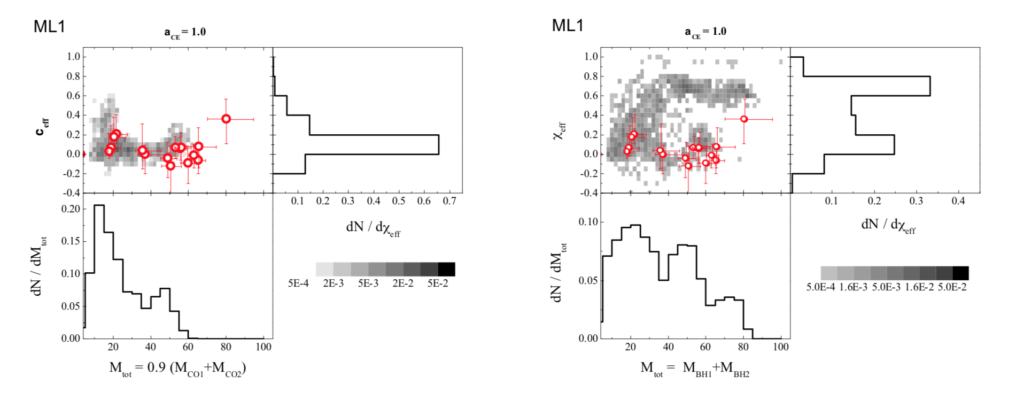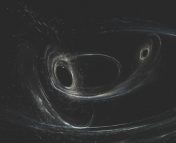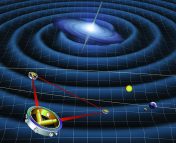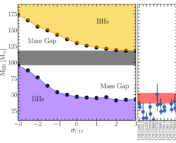Title: Black hole spins in coalescing binary black holes
Authors: K. A. Postnov and A. G. Kuranov
First Author’s Institution: Sternberg Astronomical Institute, Moscow M.V. Lomonosov State University, Russia
Status: Published in MNRAS
Everything you could possibly want to know about a black hole can be boiled down to three quantities – its mass, its spin, and its charge. We normally assume the charge of black holes to be negligible, and various methods have gotten pretty good at measuring the mass of black holes… but what about the spin?
One of our newest insights into black holes has been through the gravitational wave detections by the LIGO/Virgo collaborations. When two black holes get close enough together, they start spiralling in on each other and eventually merge. This is such a violent process that the gravitational waves emitted before, during and after the crunch can be felt by our detectors on Earth. In the past 3 years, 10 black hole mergers have been confirmed, and 18 more candidates are yet to be confirmed from the most recent observing run that began in April of this year.
We can work out things like the distance to the merger, the masses of the black holes and the spins of the black holes by matching the observed gravitational wave signal to templates with our theoretical predictions. Whilst the masses of the individual black holes can be reasonably well constrained, the individual spins of the black holes are tricky to pin down. Gravitational wave detectors are only sensitive to a combination of both black hole’s spins and masses known as the effective spin which can be difficult to untangle, and what’s more, the observed effective spin for all 10 mergers has been very low. This is perhaps a little surprising, since we expect the stars that collapse to form the black holes to be spinning, and therefore unless the resultant black holes don’t inherit their star’s spin, or if they’re spinning in exactly opposite directions, the combination in the effective spin shouldn’t be close to zero – so what’s going on?
The author’s of today’s paper try to tackle this problem by tracking the evolution of spinning massive stars in binary pairs as they collapse to form black holes, and then compare the effective spin prediction with observations from LIGO/Virgo. They do this by modifying a binary star evolution code to account for low metallicities, which allows the existence of massive enough stars that don’t lose too much of their mass over time, as well as considering two different models for the transfer of angular momentum from the stars to the black holes.
In the first model, just the angular momentum of the core of the star that collapses is assumed to be transferred to the black hole. Whilst in the second, there is extra angular momentum due to matter falling back into the black hole from the rotating ‘envelope’ around the core.
After running a million combinations of initial masses and spins, they can compare the expected effective spins for each set-up with the observed results from LIGO/Virgo. They find that the first model (where just the stellar core angular momentum contributes to the black hole spin, see left hand side of figure 1) produces low effective spins, and therefore matches the observations from LIGO/Virgo! However, the predicted final masses of the black holes can’t account for one of the heaviest observations dubbed GW170729, so the formation mechanism can’t be quite right for this case at least.

The second model (see the right hand side of figure 1) where there’s extra spin due to additional fallback from the rotating envelope onto the black hole does manage to predict the correct mass-range to match up with LIGO/Virgo observations, but the effective spin distribution is much wider, and therefore isn’t such a good match for the narrow distribution of effective spin observations around zero. Perhaps this means that the group of black holes seen so far can’t be explained by one single formation process alone, and in fact there are multiple populations being observed here. Or, the black holes might not have formed from stellar collapse at all…
Primordial black holes might have formed in the very early stages of the Universe, and they can form with any mass, and are expected to have little to no spin. They’re also a dark matter candidate, which is why lots of people have gotten very excited about the prospect of their detection. The authors mention, and go on to show in a follow up paper, that in terms of their spin distribution, it looks like a population of ten or so primordial black holes could well fit the LIGO/Virgo observations. However various people have pointed out that we should have seen many more of them by now if they were also to make up all of the dark matter.
For now, it looks like there’s still work to do in order to come up with a concrete model for stellar collapse black holes that could be consistent with both the masses and spins of the black hole mergers observed by LIGO/Virgo. With more and more detections expected as the third LIGO/Virgo observing run gets under way, hopefully more signatures will show up so that we can pin down the black holes’ origin, be it from the big bang of the Universe, or from the big pop of a star going out.




